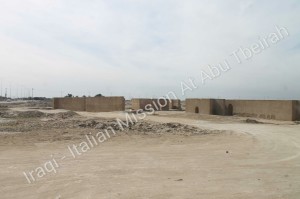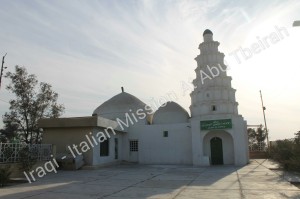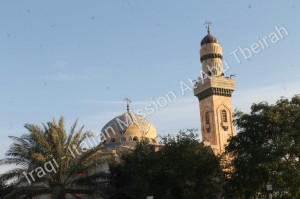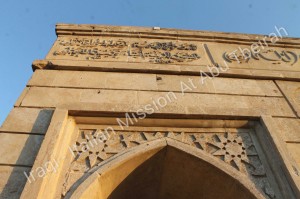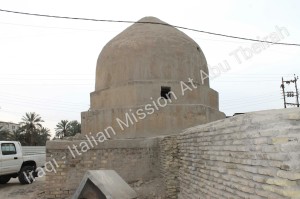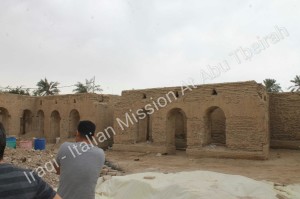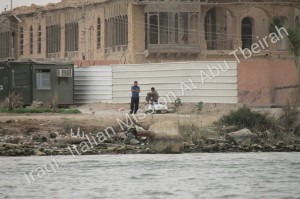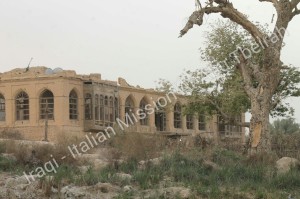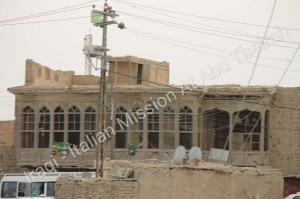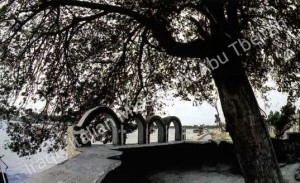ZUBAIR
Excavations of the ancient Basrah city:
Given the heavy urbanization of this area, it is difficult to appreciate today the importance of the site from the historical and archaeological point of view. Recent excavation have brought to light buildings of the Islamic periods belonging to the ancient city of Barsa. Only one of these buildings, already has been restored.
Hassan al Basri Grave and Sunni Cemetery.
Coordinates 38R QU 59345 MGRS 64540.
The grave of Hassan al Basri and the cemetery surrounding it can represent a nice attraction for tourists interested in the Islamic culture. The grave is located in a Sunni cemetery. Unfortunately most of the ancient graves have been destroyed by a flood in the ‘30s of the last century.
Imam Ali Mosque.
The new structure was built in 1996. Only the minaret of the ancient building is preserved. An archaeological site, until now unexcavated, lies inside the courtyard of the mosque.
Talha Ibn Abdullah Mosque
The mosque was destroyed by bombings in 2008. It will be rebuilt in the future – perhaps it could be interesting to keep a part of it unbuilt in order to show the most recent history of Basrah and Iraq.
Coordinates 38R QU 62495 MGRS 66312.
Abu Al Giawzi Grave
Abu Al Giawzi was the founder of a new way of interpreting Sufism; his grave lies along the main street to Zubair and is inside an inhabited area. The building is quite interesting from the touristic point of view, but needs restoration and musealization (a workshop for stone curving has been built alongside the wall of the grave itself).
Sayab’s House
The house of the famous Basrah poet is under restoration. It will host an important cultural center for the area of Zubair.
Yusif and Hashim al- Nakib Palaces
These two palaces, on the Shatt el Arab, are wonderful examples of Ottoman architecture. Only Hashim Palace can be now visited, nevertheless some families have built their houses inside them. The SBAH, that recently acquired both palaces, will proceed to the restoration of this two buildings.
Hashim al-Nakib Palace
13 families live now in the area and inside the building in conditions of extreme poverty and dirt, and are partially destroying the structure, edifying modern houses on the ruins. The palace can be reached with car or by boat from the Shatt el Arab, and can become an important touristic attraction for its splendid architecture and location.
The palace has three floors and presents the typical architecture in bricks and mud with ceiling realized in reed-mat and wood. The central court and the wooden shanashil are surely worth a visit.
Bab Tawil Palace
Located in Jicor village, the palace has been acquired by the SBAH and must be restored.
Adam three and Qurna
Qurna (Arabic for corner) is a pleasant little place 74 km north west of Basra at the very tip of the point named Shatt El-Arab where the two great rivers Tigris and Euphrates meet; a strategic position that has been the scene of conflicts for centuries. As legends remember, Qurna is the reputed site of the Gardens of Eden. Eve’s Tree -the Tree of Knowledge- (or Adam’s tree) stands at Qurna.
Gli scavi della città antica di Bassora:
Data la forte urbanizzazione della zona, è difficile apprezzare oggi l’importanza del sito dal punto di vista storico e archeologico. Recenti scavi hanno portato alla luce edifici del periodo islamico appartenente all’antica città di Bassora. Solo uno di questi edifici è stato già restaurato.
Tomba di Hassan al Basri Tomba e cimitero sunnita.
Coordinate 38R QU 59345 MGRS 64540.
La tomba di Hassan al Basri e il cimitero circostante può rappresentare una bella attrazione per i turisti interessati alla cultura islamica. La tomba si trova in un cimitero sunnita. Purtroppo la maggior parte delle antiche tombe sono state distrutte da un’alluvione negli anni ’30 del secolo scorso.
Moschea Imam Ali
La nuova struttura è stata costruita nel 1996. Si conserva solo il minareto dell’antico edificio. Un sito archeologico, fino ad ora non scavato, si trova all’interno del cortile della moschea.
Moschea Talha Ibn Abdullah
La moschea è stata distrutta dai bombardamenti nel 2008. Sarà ricostruita in futuro forse potrebbe essere interessante mantenere una parte di essa non riedificata al fine di mostrare la storia più recente di Bassora e dell’Iraq.
Coordinate 38R QU 62495
Tomba Abu Al Giawzi
Abu Al Giawzi è stato il fondatore di un nuovo modo di interpretare il Sufismo; la sua tomba si trova lungo la strada principale di Zubair, ed è all’interno di un centro abitato. L’edificio è molto interessante dal punto di vista turistico, ma ha bisogno di un restauro e una musealizzazione (un laboratorio per la curvatura della pietra è stata costruita lungo il muro della tomba stessa).
Casa di Sayab
La casa del celebre poeta di Bassora è in fase di restauro. Esso ospiterà un importante centro culturale per l’area di Zubair.
I Palazzi Yusif e Hashim al-Nakib
Questi due palazzi, sullo Shatt el Arab, sono splendidi esempi di architettura ottomana. Solo Hashim Palace è ora visitabile, tuttavia alcune famiglie hanno costruito le loro case al loro interno. Il SBAH, che ha recentemente acquisito i due palazzi, procederà al restauro di questi due edifici.
Hashim al-Nakib Palace
13 famiglie vivono ora nella zona e all’interno dell’edificio in condizioni di estrema povertà e sporcizia, e stanno in parte distruggendo la struttura, edificando case moderne sulle rovine. Il palazzo è raggiungibile in auto o in barca dallo Shatt el-Arab, e può diventare un importante attrazione turistica per la sua splendida architettura e posizione.
Il palazzo ha tre piani e presenta la tipica architettura in mattoni e fango con soffitto realizzato in canna e legno. La corte centrale e la shanashil in legno sicuramente meritanouna visita.
Palazzo Bab Tawil
Situato nel villaggio di Jicor, il palazzo è stato acquisito dal SBAH e deve essere ripristinato.
L’albero di Adamo e Qurna
Qurna (in arabo angolo) è un piacevole luogo a 74 km a nord ovest di Bassora, all’estremità del punto chiamato Shatt el-Arab, dove i due grandi fiumi Tigri ed l’Eufrate si incontrano; una posizione strategica che è stata teatro di conflitti per secoli. Come le leggende ricordano, Qurna è il rinomato luogo dei Giardini dell’Eden. L’albero di Eva -della conoscenza (o albero di Adamo) si attesta a Qurna.
